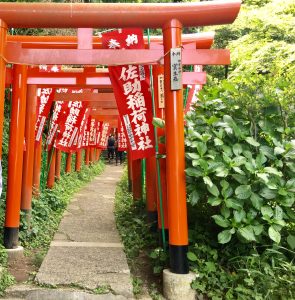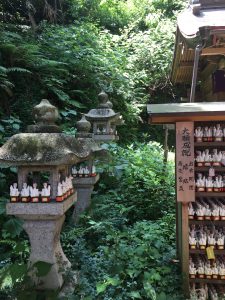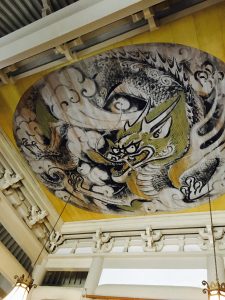Luckily we got to sit on the train toward Kamakura, because what was awaiting us were a thousands of stairs and steep slopes…
Our first stop was a Zen Buddhist temple which featured a three-claw dragon (apparently it was a trend for some period for dragons to be painted in this fashion and there are only a few of such kind). Also featured in this temple were representations of the monks who are responsible for introducing Zen Buddhism to Japan, one of them which was Dogen…
and so the second part of my final exam for Professor Christmas’s “Culture and Conquest: Intro to Japanese Pre-modern History” (a course I took this past spring semester) began. Learning about the Kamakura shogunate as well as other eras of Japanese pre-modern history really helped me appreciate the hike through Japan’s medieval city…
Even though the very nature of the Daibutsu (Big buddha) over powers the rest of the the places n Kamakura, my favorite part of the hiking pilgrimage was the Inari Shrine, which was hidden in the woods. With Noto-San (see Trip Day 5) we leaned the basics of Shinto, in which we learned the what the Torii Gate symbolizes. While there were two theories of surrounding the origin of the kanji for Torii the one I prefer translates to “Bird, stay.” Because birds navigate the sky, the are seen almost as messengers of kami. Having the Torii gate at the entrance invites the kami to stay. What is special to Inari Shrines is that they have multiple consecutive Red Torii gates, which just looks gorgeous…


The Kitsune shrine appears in Kamakura because, as legend has it: it was this deity this particular deity that appeared to Yoritomo and encouraged him to rebel against the Taira regents and establish what is now known as the Kamakura Shogunate (the first shogunate ever!); the establishment of the the shogunate would forever change the course of Japanese history and culture.
Throughout the various stops along the hiking tour a series of oral pop-quizes on Japanese were issued… After learning Japanese Pre-modern History from Professor Christmas and about the fantastic with Professor Selinger in a classroom setting, it was fascinating to learn from them in their state of excitement as they explain and tell on their field of expertise…
FUN Fact: Naruto (an anime series that I really like) integrates much of Japanese ancient history and shinto symbols in its plot line and characters.

